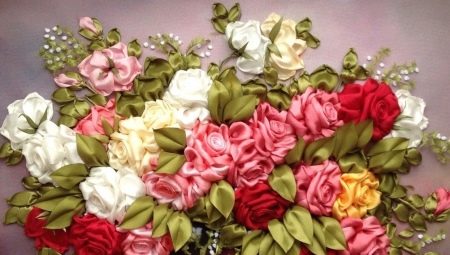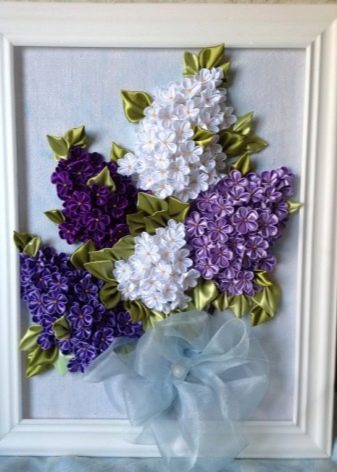Satin ribbon paintings

Satin ribbon paintings are a rather unusual type of needlework. The art of creating ribbon embroidery emerged at the end of the 14th century in France. Thanks to the use of shiny ribbons in various shades, a voluminous work is obtained that looks very beautiful. Such a picture will serve as a wonderful decoration for any interior.


What do you need to work?
A feature of paintings embroidered with ribbons is that the result is a bright and three-dimensional image. It is almost impossible to create two completely identical works. In order to create a picture from tapes, it is necessary to prepare in advance certain materials that will be required in the process of work:
- satin ribbons of selected shades of suitable width and length;
- a special marker for needlework (for drawing a sketch on the fabric);
- glue gun;
- dense fabric for the base of the product (canvas, canvas, linen);
- a needle with a wide eye and a blunt end;
- threads for securing individual parts on the basis of the picture;
- scissors;
- lighter or matches;
- frame;
- hoop.



It is very convenient to work with satin ribbons. This material has a number of advantages:
- it is possible to choose tapes of different widths;
- a wide variety of shades;
- the tapes are quite strong;
- retain the brightness of colors and an attractive appearance for a long time.

Types of stitches
When creating a picture from satin ribbons, different types of stitches are used. These are straight and tape stitch, twisted stitch, loop and back stitch. Other types of decorative seams can also be used. A French knot is used for embroidery of small details.
In order to ensure the fastening of the tapes on the base, a blind seam is used. It allows you to fasten the tapes from the seamy side of the work in such a way that this seam is not visible on the front side.
Basic stitches are:
-
circular loops;
-
half-loops with attachment;
-
loops with attachment;
- twisted loops.


Diy ribbon embroidery instructions
To create a product, you need a base fabric. Canvas is most commonly used, but other types of fabric can be used. The only condition is that the fabric should be quite dense. For work, you also need a special needle with a wide eye. This is necessary so that the tape can pass into the eye of the needle.
Before starting work, you need to choose the plot you like. Most often, a floral theme is used to create such paintings. These can be roses, lilacs, daisies, peonies, poppies, or other flowers. But the plot can be absolutely anything. For beginners, it is best to opt for simple drawings that do not contain too complex details. It is best to give preference to drawings with several large elements. Over time, you can choose more complex compositions.


After that, the selected sketch must be transferred to the fabric base. The next step is to hoop the canvas in a suitable hoop. When the fabric is well stretched, the embroidery process is faster, and the finished work looks more neat: the ribbons lay flat on the base, and the stitches look neat.
To achieve a sense of heterogeneity and an attractive overflow of the composition, you can tint the drawing using acrylic paints. And you can also draw some details with paint (veins on the leaves, blades of grass, etc.).
After completing the embroidery, the finished work must be fixed in the frame. It can be hung on the wall or presented as a holiday gift.


Kanzashi paintings
The eastern technique of kanzashi needlework allows you to make a variety of flowers that can be used as various accessories and ornaments (for example, brooches, hair clips, decor for women's handbags, and much more). However, this technique can also be used to create paintings from satin ribbons. Roses, lilacs, sunflowers, chamomiles and other flowers made using the kanzashi technique look beautiful.


To form a rose from satin ribbons, you need to twist a small bud and sew it to the base of the picture. After that, with your fingers, you need to create new petals, and each of them is carefully fastened to the fabric using a needle and thread of a suitable shade. Thanks to this technique, flowers of various sizes and shapes can be created. These can be very small buds or fully blossoming roses.


A rose can also be formed using another method. To do this, cut a wide satin ribbon into squares, which then need to be folded into a triangle. To create one flower, it is enough to use seven blanks. For the middle of a rose, two blanks must be folded with sharp ends towards a right corner and fixed. You can collect all the petals with glue, or using threads and a needle.


In this way, you can create not only roses, but also other flowers. To form individual petals, the square workpiece must be folded in half, and then folded again. As a result, you will get a part of a smaller shape, from which you can create a volumetric petal, fix the structure with glue or threads. After the required number of petals has been prepared, they need to be connected to the fabric base of the picture.

Various techniques can be used to embroider leaflets. Straight stitches can be used to fit the stem of the plant. Another option is to cut the leaves from a wide green ribbon, singe the edges, and sew to the base.
For the core of the flowers, you can use a floss of a suitable shade, beads strung on a wire, or cut out a circle of the desired diameter from felt. Another possibility of creating a core of a flower is to use a thin satin ribbon that is curled and fixed to the canvas.



A beautiful picture, embroidered with satin ribbons, will serve as a wonderful decoration for any interior... You can create simple compositions without even having any experience. With the growth of skill, the plots of the paintings can be complicated, additional elements can be added, and real masterpieces can be embroidered. Flowers in such paintings are very similar to living buds, and the work itself does not leave anyone indifferent.

Next, see a master class on embroidering paintings with satin ribbons.






